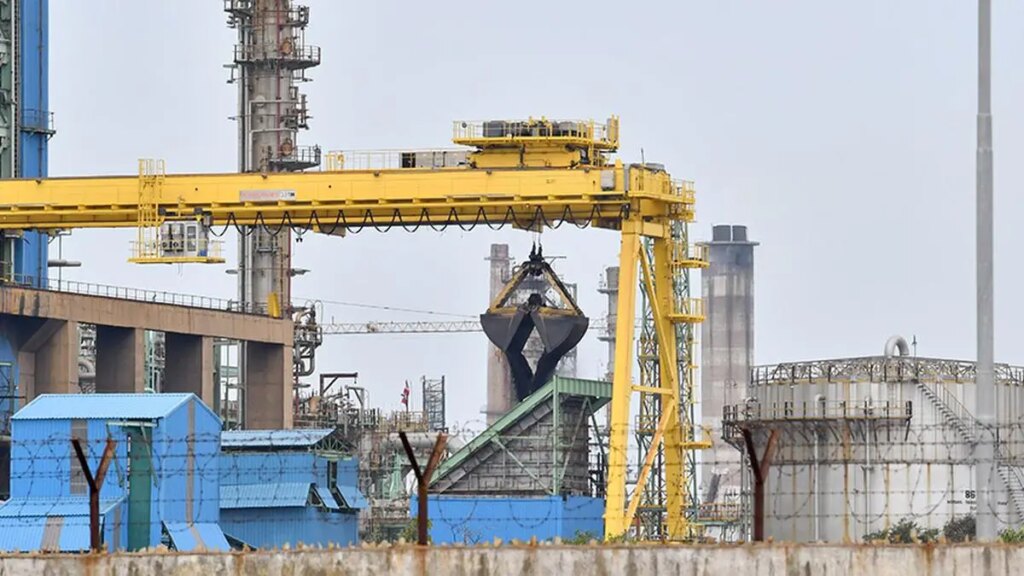
CPCL reports decline in net profit for March quarter and FY25
CPCL Financial Performance: Net Profit Declines in Q4 and FY25 Amid Lower GRM
The CPCL financial performance for the March quarter and fiscal year 2025 shows a substantial decline in profitability due to falling gross refining margins (GRM) and reduced operational output. Chennai Petroleum Corporation Ltd reported a consolidated profit after tax of just ₹214 crore for FY25, down dramatically from ₹2,745 crore in the previous year. Despite this challenging CPCL financial performance, the Board of Directors has recommended a dividend of ₹5 per equity share, representing a 50% payout on the face value of ₹10 per share for the fiscal year 2024-25.
Revenue from operations for FY25 amounted to ₹71,050 crore, lower than the ₹79,272 crore recorded in FY24. Photo Credit: VELANKANNI RAJ B
CPCL Financial Performance Analysis
Quarterly Performance Analysis
The CPCL financial performance for the quarter ending March 2025 reflects significant challenges in the refining sector. Chennai Petroleum Corporation Ltd reported a consolidated profit after tax of ₹470 crore for the fourth quarter of FY25, representing a 25.2% decline from the ₹628 crore recorded in the corresponding quarter of the previous fiscal year.
Revenue from operations during the quarter stood at ₹20,581 crore, slightly lower than the ₹20,823 crore registered in the same period of FY24, marking a marginal decrease of 1.2%. This relative stability in revenue despite the significant profit decline indicates pressure on margins rather than sales volume as the primary challenge affecting the CPCL financial performance.
Annual Financial Results FY25
The annual CPCL financial performance shows a more dramatic deterioration compared to the quarterly results. For the full fiscal year 2025, Chennai Petroleum Corporation Ltd reported a consolidated profit after tax of ₹214 crore, which represents a steep 92.2% decline from the ₹2,745 crore recorded in FY24.
Revenue from operations for the full year FY25 amounted to ₹71,050 crore, showing a 10.4% reduction from the ₹79,272 crore recorded in FY24. This reduction in revenue, coupled with the much steeper fall in profitability, indicates a significant compression in margins and highlights the challenging operating environment that impacted the CPCL financial performance throughout the fiscal year.
Key Financial Metrics Comparison
| Metric | FY25 | FY24 | Change (%) |
|---|---|---|---|
| Profit After Tax | ₹214 crore | ₹2,745 crore | -92.2% |
| Revenue from Operations | ₹71,050 crore | ₹79,272 crore | -10.4% |
| Average Gross Refining Margin | $4.22 per barrel | $8.64 per barrel | -51.2% |
| Crude Throughput | 10.454 million tonnes | 11.642 million tonnes | -10.2% |
| Debt-Equity Ratio | 0.39 | 0.32 | +21.9% |
| Net Worth | ₹7,938.5 crore | ₹8,593 crore | -7.6% |
Gross Refining Margins Decline
A critical factor in the weaker CPCL financial performance was the substantial decline in average gross refining margins (GRM), which fell to $4.22 per barrel in FY25, down sharply by 51.2% from $8.64 per barrel in FY24. This significant contraction in the GRM directly impacted the company’s profitability despite relatively modest reductions in operational metrics.
Gross refining margin, which represents the difference between the total value of petroleum products produced by a refinery and the price of crude oil, is a key profitability indicator for refining companies. The sharp decline in GRM reflects challenging global market conditions, including compressed spreads between crude oil prices and refined product values, which have substantially affected the CPCL financial performance during the fiscal year.
Understanding GRM Impact
A $1 change in GRM for CPCL typically translates to approximately:
- ₹500-600 crore impact on annual profit
- With a decline of $4.42 per barrel ($8.64 to $4.22), the GRM reduction alone accounts for approximately ₹2,200-2,650 crore of the profit decline
- This explains the majority of the ₹2,531 crore reduction in profit after tax from FY24 to FY25
- GRM volatility remains one of the most significant risk factors for refinery financial performance
Operational Performance Metrics
The CPCL financial performance was also affected by operational factors, particularly the reduced crude throughput at the company’s Manali refinery. Although the refinery has a nameplate capacity of 10.5 million tonnes (mt), CPCL achieved a crude throughput of 10.454 mt in FY25, representing a 10.2% decrease from the 11.642 mt achieved in the previous year, which had marked the company’s highest-ever physical performance.
The company attributed this reduction in throughput to “major maintenance & inspection shutdown undertaken in various process units such as CDU-II, FCCU, DCU, and OHCU” during the fiscal year. These scheduled maintenance activities, while necessary for the long-term operational efficiency and safety of the refinery, had a direct impact on the CPCL financial performance by reducing the overall processing volume and operational efficiency.
It is noteworthy that despite the scheduled maintenance, the refinery operated at approximately 99.6% of its nameplate capacity, which demonstrates strong operational efficiency within the constraints of the maintenance schedule. However, the 10.2% year-on-year reduction in throughput, combined with the 51.2% decline in GRM, created significant headwinds for the overall CPCL financial performance.
Financial Position and Debt Profile
The challenging CPCL financial performance during FY25 has also affected the company’s financial position. The debt-equity ratio increased to 0.39 as of March 31, 2025, compared to 0.32 as of March 31, A2024, representing a 21.9% increase. This higher leverage indicates a potential increase in financial risk, though the ratio remains within manageable levels for the industry.
Concurrently, CPCL’s net worth declined by 7.6%, standing at ₹7,938.5 crore as of March 2025, compared to ₹8,593 crore in March 2024. This reduction in net worth, coupled with the increase in the debt-equity ratio, reflects the impact of the weaker financial performance and potentially higher leverage used to maintain operations during a challenging period for the CPCL financial performance.
Dividend Announcement Despite Challenges
Despite the significant decline in the CPCL financial performance, the Board of Directors has recommended a dividend of ₹5 per equity share for the fiscal year 2024-25. This dividend represents 50% of the face value of ₹10 per equity share and demonstrates the company’s commitment to delivering shareholder returns even amid challenging operating conditions.
The decision to maintain a substantial dividend payout ratio despite the steep decline in profitability may reflect management’s confidence in the company’s ability to navigate the current challenges and potentially bounce back in the coming fiscal year. It also suggests that the company views the current CPCL financial performance challenges as temporary rather than structural in nature.
Dividend Analysis
- FY25 Dividend: ₹5 per share (50% of face value)
- Total dividend outflow: Approximately ₹74.5 crore (based on outstanding shares)
- Dividend payout ratio: 34.8% of FY25 profit after tax
- The dividend strategy signals management’s confidence in future cash flows despite current profitability challenges
- Maintaining dividend provides support for shareholder value during a period of weaker share price performance
Future Outlook and Challenges
Looking ahead, several factors will likely influence the CPCL financial performance in the coming fiscal year. The company’s ability to improve its gross refining margins will be crucial for a recovery in profitability. Global refining margins are subject to numerous factors, including crude oil prices, product demand-supply dynamics, and geopolitical developments, all of which will play important roles in determining CPCL’s financial trajectory.
With the completion of major maintenance activities during FY25, CPCL may be positioned for improved operational performance in the next fiscal year. If the company can return to its previous throughput levels while benefiting from any potential recovery in refining margins, the CPCL financial performance could show significant improvement.
However, challenges remain, including:
- Continued volatility in global crude oil prices and refining margins
- Potential changes in domestic fuel pricing and taxation policies
- Competition from newer, more efficient refineries in the region
- The ongoing energy transition and evolving regulatory landscape around carbon emissions
- Managing the higher debt-equity ratio while funding necessary capital expenditures
The CPCL financial performance in FY25 clearly illustrates the cyclical nature of the refining business and the significant impact that market conditions can have on profitability. While the current results represent a substantial year-on-year decline, the maintenance of dividend payouts and the company’s continued operational focus suggest management is taking a long-term view of the business despite the near-term challenges.






